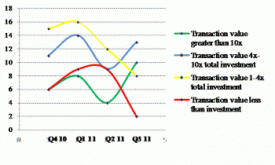M&A is Hot
As the IPO market came to an abrupt halt, the M&A market rendered brighter returns. For the first three quarters of 2011, venture-backed M&A activity, by value, was up 43% compared to the first three quarters of 2010. During Q3 2011 alone, 101 venture-backed M&A transactions were reported with the average transaction valued at $181.3 million, up 17% from Q2 2011.
The most important trend is improved returns to investors. During Q3 2011, 30% of the transactions returned greater than 10x the amount invested and only 6% returned less than the amount invested. The chart below illustrates this trend by utilizing disclosed transaction data for the past twelve months.

IPOs are Not
During Q3 2011, there were approximately 68 US-based, VC-backed companies in queue to go public. Not surprisingly, only 4 were bold enough to dip their toes in the murky waters. In fact, the number of IPOs decreased 77% from Q2 2011, raising only $442.9 million, which is down 92% from Q2 2011 and the lowest for venture-backed IPOs since Q4 2009.
Navigating the Path
At Atelier Advisors inaugural CEO dinner, a gathering of friends running companies, I had a chance to catch up with a few founders on the liquidity path. I spoke with Haydar Haba, founder of IntelePeer, a company that was scheduled to go public this summer, on his decision to postpone an IPO. Needless to say, the decision to postpone an IPO is always a tough one, but with current market conditions it’s better to be safe than sorry. As of this blog post, 40% of the companies that went public in Q3 2011 are trading below their offer price. On the other side of the table, literally and figuratively, Rodrigo Flores, founder and CTO of newScale, which sold to Cisco this April, was relieved to be on the other side of the transaction. He noted, and I agree, that M&A always takes longer than companies anticipate. Similar to raising capital, you want to begin the process long before you think you need to make a decision.
If you are looking for liquidity in the near future, begin now. You may not want to exit for another year, but begin having conversations with your team today. Create a list of ideal acquirers and get to know them. You’ll want to understand how they would integrate your products and services. In most acquisitions, key players are required to stay on for a set period of time. Not only are you looking for an acquirer, you are looking for your next employer. Start “interviewing” your future boss today.

